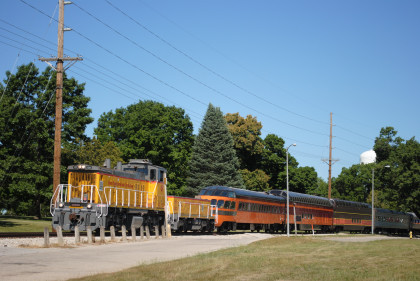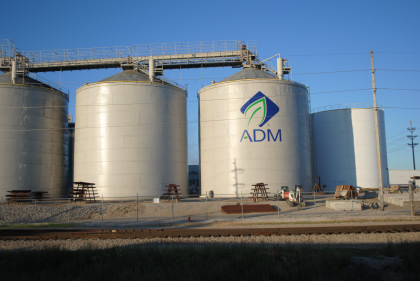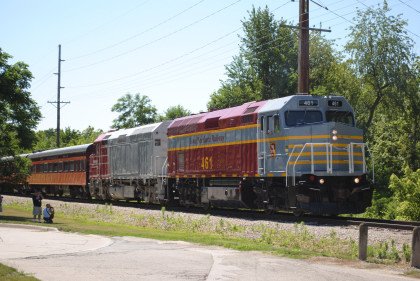
I arose at 4:30 AM and after putting my corrections into my stories and uploading them {thank you Winston and Elizabeth}, I finally updated my rail mileage then walked over to the Clarion Hotel for a safety meeting. We took the crew bus out to the Smith-Dow Yard and everyone boarded the train to Swisher.
Cedar Rapids & Iowa City Railway HistoryThe Cedar Rapids & Iowa City Railway, like many former interurban railroads, has a somewhat complex heritage with a mixed mission. As electric railway technology advanced, proposals for electric lines became common throughout the country. In 1903, the Cedar Rapids Electric Light & Power Company was engaged in the business of furnishing light and power and steam heat for the city of Cedar Rapids. At the same time, there was a paper company known as the Cedar Rapids, Iowa City and Southern Railway that was proposing to build southward toward Missouri. The two companies chartered the Cedar Rapids & Iowa City Railway & Light Company during May 1902, which in turn organized the Iowa Railway & Light Company.
According to the McGraw Electric Railway Manual of 1914, the Iowa Railway & Light Company acquired in 1912 the Marshalltown Light, Power & Railway Company; the Boone Electric Company; the Marion Light, Heat & Power Company; the Perry Electric Light, Power & Heating Company; the Tama & Toledo Railway Company and the Tama & Toledo Electric Power Company. It further stated that the "Iowa Railway & Light Company owns and operates the electric light and power properties in Cedar Rapids, Marshalltown, Boone, Marion, Perry, Tama, Toledo and Blairstown; an interurban electric railroad between Cedar Rapids and Iowa City, and between Tama and Toledo; the local street railways in Marshalltown and Boone; the gas plant in Marshalltown, and the heating properties in Cedar Rapids, Boone, Marion and Perry".
The Cedar Rapids & Iowa City Railway (reporting marks CIC, also known as the Crandic), formally established under the name Iowa Railway & Light Company, started construction on an interurban line between Cedar Rapids and Iowa City during the summer of 1903. On August 13, 1904, the railroad began passenger and LCL freight service between its namesake cities, and carload freight in 1907. While this line still exists as the Crandic's First Subdivision, other lines were also operated by the railroad. For example, from 1913 to 1928, the railway had a line to the southeast to Mount Vernon and Lisbon. As with many interurbans, the increase in private automobiles and the depression years brought about many changes.
To respond to these challenges, Crandic Stages, an intercity bus company, was started in 1929 and sold to Nevin Bus Line in 1933. In 1939, a last effort was made to compete with the automobile when the Crandic purchased six high-speed light weight cars (Red Devils, called Comets on the Crandic) from the defunct Cincinnati & Lake Erie Railroad. The rocking motion on the track built for slower speeds lead to the popular saying "Swing and Sway the Crandic Way". The purchase of these cars came at a fortunate time as World War II increased ridership, peaking in 1945. However, with the prosperity after the war, the private automobile again attacked the railroad's ridership and passenger service ended. The last official run of a Crandic passenger train occurred on May 30, 1953. This "Rail Fan Passenger Special" marked the end of the Crandic Interurban era and was operated as a charter for railfans, including members of the National Railway Historical Society.
Ironically, just as the demand for passenger service was ending, freight revenues increased in the same proportions. In 1953, the Crandic converted to an all-diesel fleet to handle this business. The business base in Cedar Rapids grew quickly through the 1960s, with the addition of customers like Corn Sweeteners, now Archer-Daniels-Midland, in 1968. In 1980, the railroad expanded with the acquisition of two additional rail lines. With the demise of the Milwaukee Road, Crandic purchased the Cedar Rapids-to-Homestead route. Additionally, the railroad bought the Iowa City to Hills portion of the former Chicago, Rock Island and Pacific Railroad. The failure of the Rock Island had other impacts, as the former connection to Chicago markets at Iowa City became uncertain. To help solve this problem, the Crandic invested in the Council Bluffs to Chicago line, now the Iowa Interstate. Because of the growth in business, the original connection at Iowa City became unsuitable.
The two railroads (CIC and IAIS) agreed upon a new connection near Homestead, called Yocum Connection. In 2001, this route became the preferred one. In August 2004, the Crandic turned over the road train between the two railroads to the Iowa Interstate, instead choosing to focus its efforts on local switching. In 2005, Railway Age magazine named the Crandic its Short Line Railroad of the Year. In 2011, the Cedar Rapids and Iowa City Railway Company and Archer Daniels Midland (Archer-Daniels-Midland) were the winners of the Argus Win-Win Award, an annual honor is given to railroads, shippers and organizations that develop innovative partnerships leading to improved service, efficiency and other mutually beneficial service improvements. This is the second time that the Crandic has won the award.
Today, Crandic operates 60 miles of main line track and nearly 40 miles of industry track, handling more than 90,000 carloads each year, and still growing. The railway is owned by Alliant Energy Transportation company, today's ancestor of the original Railway & Light Company. The Crandic fleet is made up of almost all switch engines (mostly SW1500 and MP15DC) and yard slugs. Their heritage includes Kansas City Southern, Milwaukee Road and Denver and Rio Grande Western. Notice the paint scheme. Reportedly, the Crandic's yellow and grey predates that of Union Pacific!
The Train's ConsistIowa Northern F40PH 451 and 678, NSRX coach 202 "Wenonah" PPCX 800261, NSRX coach 203 " Nokomis" PPCX 800898, NSRX coach 7616 "Lake Pepin" PPCX 800799, NRHX 142 "Franklin Inn" PPCX 800957, "Braddock Inn" PPCX 800854, New York Central tavern lounge 38 PPCX 800655, High Iron dome 60 "Scenic View" (former Santa Fe 551), NSRX "Super Dome" 53 PPCX 800862, NRSX Skytop Lounge Observation 186 "Cedar Rapids PPCX 800040, Crandic slug 125 and MP15DC 122.
The Deadheading TripWe left the yard as I started my day of all-new rail mileage.
Views as we departed Smith-Dow Yard on this beautiful Iowa morning.
Passing a sand and gravel operation.
Our train is on former Milwaukee Road tracks here.
A siding towards the Archer-Daniels-Midland Plant.
Our train took another curve.
We were leaving the Milwaukee Road rails.
The rabbits were out and about this morning.
Curving into the Archer-Daniels-Midland Yard.
Passing the Archer-Daniels-Midland plant.
The rear of the train.

The Archer-Daniels-Midland plant.
Archer-Daniels-Midland Plant switchers.
Archer-Daniels-Midland SW1200 1204, ex. Archer-Daniels-Midlands 1 Peoria, Illinois, exx. Norfolk and Western 1204, exxx. Illinois Terminal 1204, nee Illinois Terminal 778 built by Electro-Motive Division in 1955.
Archer-Daniels-Midland SW8 1196, ex. Everready Battery 1196, exx. Southern Pacific 1196, exxx. Southern Pacific 1174, nee Southern Pacific 4628 built by Electro-Motive Division in 1954.
A view looking back at the Archer-Daniels-Midland plant.
Curving onto the Crandic mainline to Iowa City.
The Archer-Daniels-Midland plant.
The Bio Springer Plant.
Looking back at the Archer-Daniels-Midland plant.
Our train heading for Swisher, our passenger boarding location.
Another plant.
Milepost 4.
Crossing a road.
A corn field.
The Cedar Rapids airport.
Another corn field before we arrived at Swisher.
The Convention TripWe boarded the passengers as the buses arrived. I helped distribute the breakfasts then went back to the door to assist the dome car passengers to board. After the last bus, I reboarded and the train prepared to depart.
Swisher just before we left. The train headed back north to the Archer-Daniels-Midland plant and after a brief talk about the plant's history, we headed back south to Swisher and then onto Iowa City.
We returned to Swisher and my new rail mileage continued.
As we left Swisher for the last time, we crossed the main road. South of there, the train ran across a high fill.
Coralville Lake on the Iowa River.
Lake Vista is a housing development near Coralville Lake.
Coralville Lake.
This is where the old Crandic line went across the Iowa River before Coralville Lake was made.
An old bridge piling in Coralville Lake.
Our train crossed the Iowa River.
Mid-River Public Use Area and Marina. The train went by the Mid River siding full of box cars then around Young Curve.
An old stage coach stop used to be here. The train next ran through North Liberty which is a fast-growing city in Iowa.
The North Liberty water tower.
Later a corn field (what else would it be) before we reached Oakdale and our photo runby location where we all detrained and set up for reverse move 1.
The Crandic locomotives were on the front of the train.
Reverse move 1.
The photo line near the west end.
The north photo line.

Photo Runby 1 at Oakdale. Today Oakdale is a research center for the University of Iowa, was originally founded as a tuberculosis sanitarium in 1908. The site became part of the University in 1965 and the sanitarium was closed in 1981.

Reverse move 2.
Photo runby 2.
The return move. We reboarded and continued south to Iowa City.
A tank farm in Iowa City.
The Iowa River.
Crossing a stream that empties into the Iowa River.
The Iowa River.
Cutting through the hills.
We crossed the Iowa River as we neared our turn-around point.
This is as far south as our train would run today to MP 25. We would now head back north to Swisher then ride the buses back to Cedar Rapids. Another excellent trip by all the staff of the 2012 NRHS Convention.
That is what we did at the convention on this date.
| RETURN TO THE MAIN PAGE |